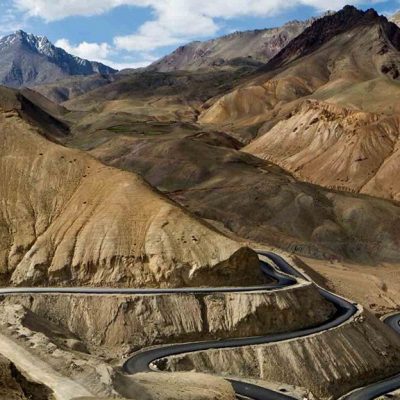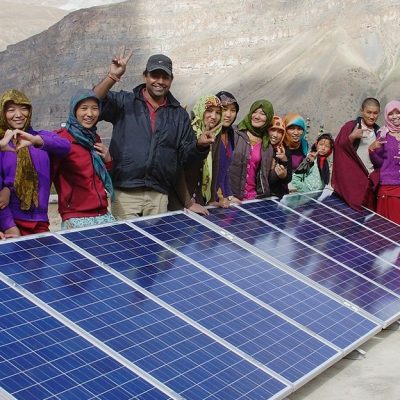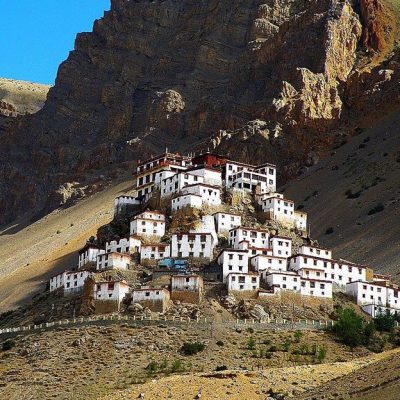The Spiti Valley: an Himalayan Kaleidoscope
16 Days
ABOUT THE ITINERARY
The Himalayas do not need much introduction, yet in this vast ocean of endless space there lie remote hidden havens that catch our imagination and enthrall us with their splendors. The western Himalayas and its hidden valleys are the focus of this trip. The Himalayan Kaleidoscope starts in the capital of Delhi and takes us to Kullu with an internal flight and from there we enter into the high deserts of Spiti.
Spiti lay isolated and closed to the outside world till as late as 1992, when it was first opened up for travelers. A well preserved Buddhist heritage, unique high altitude ecosystem and an isolation that transcends the barriers of time leaves the traveler spell bound by the magic of what we like to call the Spiti experience. The Spiti Kaleidoscope is the perfect blend of the myriad aspects of Spiti’s geo-climatic and socio-cultural heritage along with a mix of soft adventure to tickle your senses. This trip has been specifically designed with the aim of showcasing to you, within the available time “window”, a fairly comprehensive Spitian kaleidoscope. Lying in the Trans- Himalayas, the region borders Tibet in East and Ladakh in the north and bears stark ecological and cultural similarities to its neighbours. We explore the mystical hidden treasures of this valley, come face to face with Tibetan Buddhism in practice. Home to some of the oldest Buddhist monasteries and temples in the world, this trip provides an indepth insight into Spitian life, culture and Buddhist heritage. We traverse along Spiti’s (and Asia’s) highest settlements adorned by unique and ancient Buddhist monasteries and temples dating back to over a 1000 years and encased in legend and folklore. The homestay accommodation along the trail further enriches the experience by giving one an authentic understanding of the life and culture in a Spitian home. Your hosts are the local people of Spiti, accommodating you in their homes to enhance your sojourn in Spiti. We cross 2 spectacular passes to leave this valley to enter the lush green and beautiful Kullu valley. The essence of this journey lies in the subtle linkages that are built within the very fabric of this trip that ensures that the journey has minimum impacts and maximum gains for the region. This journey makes travel meaningful and beneficial for the communities, environment and the travellers. This trip redefines the conventional form of travel and gives an ingenuous essence to the spirit of travelling with a difference. From being a carbon neutral trip to being completely managed and run by the local communities this is one journey that merges conservation and travel holistically.
SIGN UP FOR THE TRIP
Registration can be requested for group travel or for self-travel. For group travel, registration is not binding. Upon reaching the minimum number of members necessary for the formation of the group, usually 4 or 6 people, you will be asked for confirmation of booking and payment of a deposit.
JOURNEY OVERVIEW AND PROGRAM DETAILS
1° Day: EXPLORE DELHI
Delhi
Arrival at Delhi airport. Transfer to the hotel for some rest. Around 10am, after breakfast, guided tour of Old Delhi. In particular, the visit includes the Red Fort (visit from the outside only), a UNESCO World Heritage Site since 2007, built in 1639 by the Mughal emperor Shah Jahan (the creator of the Taj Mahal), the Jama Masjid, one of the largest of India, where an ancient copy of the Holy Quran written on deer skin is conserved. Visit the small back streets of this part of the city like Chawri Bazar which is one of the busiest streets in Old Delhi. Later, visit Raj Ghat, the cremation site of Mahatma Ghandi. After lunch you will visit New Delhi with its luxurious buildings, such as the India Gate, an arch erected in memory of the Indian soldiers who lost their lives fighting for the British army during the First World War, and the Parliament. In the late afternoon the tour will continue to the Gurudwara Bangla Sahib, one of the most important Sikh gurdwara, or Sikh house of worship in India, known as the “Sarovar”. Then transfer to the hotel.
Overnight in Delhi
2° Day: VISIT NAGGAR
Delhi – Kullu – Naggar
After breakfast transfer to the airport for the flight to Kullu. Transfer to Naggar (approx. 1 hr jeep drive) and check in the hotel. We spend the rest of the day exploring Naggar which is home to the famous art gallery of the Russian Painter and Tibetologist, Roerich. The Naggar castle is another attraction here, which is now a government run hotel.
Overnight in Naggar. (B)
3° Day: EXPLORE MANALI
Naggar – Manali – Naggar
After breakfast we head an hour drive to Manali. Manali was once a small village is now a bustling hill station crowded with tourists lining up to visit the Snow point (Rohtang pass). The history of the place has major significance in Indian mythology as this is the center of the universe and the name of the town is derived from Manu the great Hindu sage who gave the Hindu Law – “Manusmriti”. After exploring the village return to Naggar for the night.
Overnight in Naggar.(B)
4° Day: TRANSFER TO SISSU
Naggar – Sissu
After breakfast, check out the hotel and start for Sissu. On the way we will stop in the Solang Valley. After Solang Valley, you will pass through Atal Tunnel. The tunnel is a marvel of engineering and is an attraction in itself. It connects Manali to Lahaul-Spiti valley and reduces travel time significantly. Enjoy the scenic views around. After Atal Tunnel, you will reach Sissu. Check in to your hotel and take some rest. After that, you can head out to explore the village. Sissu is located on the banks of the Chandra River, and you can take a walk along the river and enjoy the beautiful scenery around. Visit the Sissu Waterfall, which is located a short distance away from the village. The waterfall is a popular attraction and is surrounded by lush greenery. In the evening, head back to your hotel and enjoy a quiet dinner.
Overnight in Sissu. (B, D)
5° Day: HIKE AT CHANDARTAL LAKE
Sissu- Chandartal – Pagmo
Today we will move towards Spiti valley, following the Spiti river all the way up to its origin. We will drive over the Rohtang pass (separating Kullu from the Lahaul valley), from where trasnsition from the Trans- Himalayas to the Greater Himalayas. A stark contrast and a pertinent lesson in geography as we see first hand the transition from a leeward (rain-shadow) side to a rainfed area. The lush green meadows, the striking flora and the pine, cedar and oak trees make for a welcome scenery change form the stark rugged back country terrain of the Trans-Himalayas to the verdure of the Greater Himalayas. We will reach Chandratal, following the graphic valley of the Chandra river. Here we will break the journeys to the Spiti valley for one night in a tented campsite in an enchanting meadow (about 1 ½ km before the lake). You should be here by early afternoon. Do a hike of about 1 ½ hrs each way to see the exquisite Chandratal or the Moon Lake, the name in itself is mysteriously enchanting. The lake glitters like a turquoise pendant against the cold-barren mountains of Spiti valley. It is surrounded by the expansive grassy land which was a glacier in ancient times. Later we wil drive around 3 hours out of Chandra Tal to Pangmo. We will reach a nunnery where we will spend the day with the Nuns and experience the life of a Spiti nun up close. We will learn of the difficult conditions under which the nunnery was formed while the day will be spent accompanying them during their prayers, while they cook, while they debate Buddhist philosophy and while they study. We will also learn a bit of Bhoti (Tibetan script) and witness Buddhism in practice.
Overnight in Pangmo Monastry (B,L,D)
6° Day: IMMERGE YOUR SELF IN THE NUNNERY ACTIVITIES
Pangmo
Spend the day immersing yourself in the daily chores of a nun. Meditate, relax, cook, learn and just be. Overnight in Pangmo Monastry (B,L,D)
7° Day: TRANSFER TO CHICHAM VILLAGE
Pangmo – Chicham
After breakfast we will head onto Chicham village (2 to 3 hours). Chicham is a unique village and perhaps one of the greenest villages in the Himalayas. A number of initiatives ranging from decentralized green energy to solar passive houses to greenhouses to various livelihood, conservation and education initiatives to name a few. Later in evening we retire to your homestays and enjoy cooking with your host family.
Overnight in Chicham. (B,L,D)
8° Day: EXPERIENCE VILLAGE LIFE IN CHICHAM
Chicham
Today we spend the day at Chicham. We have the option of hiking to a spectacular vantage spot close to 5000 mts from where one can get a panoramic view of the Spiti and spot close to 18 villages on a clear day. If you are interested, you can volunteer with village activities like farming, cattle herding, construction etc. or explore the village and understand more about development works in Spiti. In the evening we will experience an evening folk expressions which give us an insight into Spiti’ culture. The village folk will showcase their traditional form of dance accompanied by songs played by the musicians using their unique traditional instruments. We are promoting these art forms to ensure their conservation and as a source of income generation for the local community especially the women and musicians (who belong to the lower castes) as well as to enable an enhancement in their social status.
Overnight in Chicham. (B,L,D)
9° Day: VISIT KEY MONASTRY
Chicham -Key- Langza-Kaza
After breakfast transfer to Kibber, situated at the height of 4205 meters above sea level. Later visit Key monastery. Key Gompa, also known as the ‘Monastery at the Center of the Mandala’, is the largest monastery in Spiti and holds great spiritual significance. It is home to approximately 200 monks who receive a secular and religious education up to the tenth grade before going on to more advanced Buddhist teachings. Key Monastery holds an annual festival that draws devotees and tourists alike. During this festival, traditional rituals, masked dances, and chanting ceremonies take place, offering a glimpse into the vibrant cultural tapestry of the region. Later visit Langza village, specialized in Pottery. But nowadays, there is only one potter left. Allow yourself a visit to this last surviving potter, and try out the potter’s wheel yourself! You can play with clay and learning the basics of traditional Spiti pottery, make your own Spiti Souvenir! Head back to Kaza subsequently.
Overnight in Kaza (B, D)
10° Day: EXPERIENCE YAK SAFARI
Kaza-Komic-Kaza
After breakfast head onto Hikkim – Asia’s highest post office and send off a postcard to family back home. Later tranfer to Komic village, Asia’s highest village. Visit the Komic monastery and once your settled in and you can explore the village and take a walk down to the fields to get a better understanding of the intricate irrigation systems and agricultural practices in the highest villages of Asia. Today you have a chance to experience a Yak safari (2 to 3 hours) across the alpine grazing pastures of the village livestock and the hunting ground of the snow leopard. After the visit trasfer to Kaza and check in the hotel.
Overnight in Kaza.(B, D)
11° Day: ASSIST AT A BHUCHENS PERFORMANCE
Kaza – Dhankhar – Pin Valley
After breakfast we head to Dhankhar. Dhankhar was the erstwhile capital of Spiti. Dhankhar also houses an ancient Monastery perched precariously between unique wind eroded structures. Remnants of the Dhankhar Fort, which housed the royal family of Spiti, still remain. A visit to the monastery, fort and other subsidiary temples leaves one spell bound at the traditional architectural marvels. The monastery has some interesting wall murals and thangkas, which are in an urgent need for restoration. The Dhankhar Monastery was recently declared as one of the 100 Most Endangered sites in the World, by ‘The World’s Monument Fund’. We with our partners have been working closely with the monastery to try and raise funds for its restoration. Today you will have a rare chance to assist to a Bhuchens performance. The Bhuchens are a unique sect of minstrel lamas who were the followers of Tholdon Gyalpo (a Buddhist mystic) who invented this art form in the 11th century in Tibet. It is a rare Tibetan Buddhist tantric performance to get rid of evil spirits and is now only found in the Spiti valley. Later we head into the Pin valley and further to the buffer of the Pin Valley National Park to a unique village dedicated to meditating monks and nuns!!
Overnight in Pin Valley National Park. (B,D)
12° Day: VISIT KUNGRI MONASTRY
Pin valley – Tabo
Today we visit the Kungri monastery in pin valley. Later trasfer to Tabo (around 2 hrs). Tabo is famous for its monastery, popularly known as the Ajanta of the Himalayas that celebrated 1000 years in 1996. Explore the village for the rest of the day.
Overnight Tabo. (B)
13° Day: TRANSFER TO KALPA
Tabo – Kalpa
Early morning drive to Kalpa (approx. 7 hrs. drive). The journey today takes us from the start desert landscape of the Spiti valley into the lush Satluj Valley. The drive is spectacular as we drive along what is commonly known as one of the World’s Most Dangerous Roads. We will cross Nako enroute and if keen, we can stop for a quick visit of the Nako lake. Kalpa offers some beautiful views of the Kinner Kailash Range.
Overnight in Kalpa. (B)
14° Day: TRANSFER TO TATTAPANI
Kalpa – Tattapani
Today we travel from Kalpa to Tattapani (around 8 hours drive) via the apple growing belt of the State to the Satluj valley. From Kalpa we start the descend through some lovely sections of forests following the Satluj. After this long journeys we will reach a beautiful resort, located in a small village in the foothills of the Himalayas in the state of Himachal Pradesh, one hour from Shimla. This is is a popular mountain tourist destination near a lake. The village located 60 km from Shimla on the banks of Sutlej River is famous for rafting and for its hot sulfur spring, that is believed to have healing properties for health ailments like stress, joint pain, fatigue and many skin diseases. After this long fatigue spend the eving in the hot thermal waters pool of the resort.
Overnight in Tattapani. (B, D)
15° Day: BATH IN A THERMAL POOL
Tattapani
During last day of this tour you will have the chance to relax before returning back to your Counntry. It is possible to have a wider range of treatments (Ayurvedic, Naturopathic and Beauty). There will be daily yoga sessions, good and healthy food, you can experience a healing bath in the sulphurous thermal waters and enjoy the wonderful view of the lake. This center is the ideal place for a complete holiday designed to take care of our health at 360 degrees.
Overnight in Tattapani. (B, D)
16° DAY: VISIT SHIMLA
Tattapani – Shimla– Chandigarh airport
We get up early today and transfer by car to Shimla. Shimla is a bustling hill station set up on seven hills and was regarded as the Queen of the hills due to its natural beauty and architectural character. It served as the summer capital of the British during the days of the Raj who desired to re-create the British environs and cultural life here. The weather, surroundings and the general mood of the place fitted well with their tastes. The town has grown exponentially after it became the capital of the state of Himachal Pradesh, which was formed in the year 1968 after it was split from Punjab. After a short visit to the town transfer to Chandigarh airport for your flight to Delhi in connection with your return flight.
ACTIVITIES
- Explore the Indian capital Of New Delhi,
- explore Naggar and the famous art gallery of the Russian Painter and Tibetologist, Roerich,
- visit the city of Manali,
- experience the life of a Spiti nun in Kaza nunnery, where you will have a chance to witness Buddhism in practice,
- discover conservation project in Chicham, perhaps one of the greenest villages in the Himalayas,
- volunteer yourself (if you wish) with Chicham village activities like farming, cattle herding, construction,
- experience an evening folk expressions where villagers will showcase their traditional form of dance and music,
- experience a Yak safari across the alpine grazing pastures of the village livestock,
- visit the Komic monastery and village, the highest village in Asia,
- explore Dhankhar, the erstwhile capital of Spiti, with its ancient monastery perched precariously between unique wind eroded structures and the Fort, which housed the royal family of Spiti,
- assist at a very rare Bhuchens (minstrel Lamas) performance, which is a Tibetan Buddhist tantric performance to get rid of evil spirits and is now only found in the Spiti valley,
- meet the last surviving potter of Langza village, and try out the potter’s wheel yourself so to make your own Spiti Souvenir,
- visit the ancient and famous monastery of Tabo, popularly known as the Ajanta of the Himalayas,
- enjoy a spectacular drive from Tabo to Kalpa along what is commonly known as one of the world’s most dangerous roads
- admire the most beautiful views of the Kinner Kailash from Kalpa,
- Recover yourself from the long travel in hot spring water resort in Tattapani before returning back home,
- discover the bustling hill station of Shimla, set up on seven hills, Which was served as summer capital of the British during the days of the Raj,
SOCIAL AND ENVIRONMENTAL IMPACT
All the itinerary has been designed in order to promote direct or indirect benefits for local communities, environment and cultural heritages. When possible we have selected traditional accommodations sensible to social and environmental issues, following general principles and practices of responsible tourism. The tour is designed to include the activities of various local and tribal communities, through the use of a number of local homestays, which get economic support from the trip. A stay in a local house should be a must during your visit to Spiti. Not only because living with a local family of Spiti will be the highlight of your trip but also because the Homestays contribute 30% to 50% of annual incomes for homestay families, now an essential supplemental source of income in the face of increasing climatic changes affecting agricultural patterns and crop yields. Homestays work on a rotational mechanism and ensure equitable benefits to all strata of the village community. Homestays in Spiti were started in 2004, and this tour also helps to conserve traditional architecture and cultural heritage. For this tour Conscious journeys partners with several social enterprise of local community of Spiti.
Some activities such as an evening of folk expressions, a Bhuchen performance, learning local pottery or how to spin yak wool into ropes, or learning meditative Buddhist art forms, to name a few, are not only extremely fascinating insights into the local heritage and art forms but also provide an incentive to these artists to conserve this age old heritage passed on from generation to generation.. You can purchase traditional handicraft at the eco-shop Kaza where you can take souvenir back to your Country.
This trip to Spiti redefines the conventional form of travel and gives an ingenuous essence to the spirit of traveling with a difference. From definitely being one of the most memorable trips of a lifetime to being a carbon positive trip to creating additional livelihoods and revenues for the local communities, this is a journey that merges conservation and travel. What if your travels could also generate a positive karmic footprint?
TIPS BEFORE DEPARTURE
As a cold mountain desert, the weather in Spiti is almost confusing! The sun’s rays are harsh enough to burn your skin, while shaded areas remain cool enough to wear a jacket. Mornings and evenings could be quite cold. Carry with you appropriate warm clothing especially for the evening. A layered wardrobe probably makes the most sense. Good walking shoes or hiking boots are essential even if you are not hiking. Because of the altitude, a hat or cap and a good pair of sunglasses are essential. Because of the long distances between towns and villages bring the medicines you’ll need along with some first-aid supplies. A good flashlight (torch), water bottle and polarizing filter for your camera will also come in very handy. A backpack is necessary to carry essentials/cameras while you are on local excursions. Monasteries and temples are places of worship, so you should be dressed accordingly. Admission might be denied to men and women wearing short pants/skirts, sleeveless t-shirts/blouses.
This itinerary offers good opportunities for cultural exchange, adventure, hiking, wildlife spotting and moderate trekking. However it is not fit for everyone, due to moderate trekking and altitude. The high altitude of Spiti (3300-5000 meters) needs considerable acclimatization for every traveller, whether or not it’s your first time to such an altitude. It’s best to make your journey up slowly via Shimla. Since few people have been to such altitudes, it is hard to know who may be affected by high altitude sickness. There are no specific factors such as age, sex, or physical condition that co- relate with susceptibility to altitude sickness. Some people get it and some people don’t, and some people are more susceptible than others. If one has not travelled to these altitudes before, it is recommended that you consult your doctor. We usually advise dosage of Diamox 2/3 days before reaching Kaza as a safe precautionary for this trip, however please consult your doctor before considering to take this medication as it does have side effects. Those with lung or heart conditions, or known breathing problems, are advised to consult their doctor before journeying up to the valley. Roads to Spiti and within Spiti are rough and mostly un-metaled hill roads. Please be warned that while the experience is exhilarating it is not the most comfortable. Persons with medical conditions that could worsen with such road travel are advised they consult their doctor. If you have any doubt please check with your physician to confirm that you are healthy to travel. Inform your doctor where you are going to see if there are any special concerns. Because of the climate and general lack of medical facilities in the villages, you should be reasonably fit before departure.
A conscious approach to travel requires a considerable capacity and willingness to adapt and adjust to the local environment and culture. If you wish to travel with us we request you to be open enough to experience local culture, religious and traditions without bias and pre-conceived ideas you might have before the departure and which belong to our Western cultural way of thinking. Exploring with fresh eyes, with patience and openness, you will be able to access the real essence of the cultural heritages and spirituality through the places and people you are going to meet; if you are ready to do this effort you will really enjoy the beauty of the rich culture and religiousness of Spiti Valley, the extraordinary of the nature, the solemnity of Buddhist monasteries.
HOTELS
HOTEL CATEGORIES: THREE-STAR SUPERIOR, HERITAGE AND GUEST HOUSE
During this tour we have selected comfortable but very simple guesthouses with clean and comfortable room with attached bath (running hot and cold water) and western toilet. When possible in the villages we provide you with a clean and comfortable room in a local house with environment friendly dry composting toilets squat toilets. In Pangmo you will be guest in a nunnery.
TRANSPORT
Private vehicles with AC according to the number of participants for all the itinerary from Kullu to Chandigarh.
WHEN TO GO
The summer months from late May to late September are the best time to visit Spiti. Spiti remains practically cut off from the rest of India for 6 months of the year. Thick Himalayan snow blocks the mountain passes, making it almost impossible for road transport to pass through, even on the Shimla-Kinnaur route. With only 250 days of sunshine in a year, winter in Spiti is a harsh affair.




